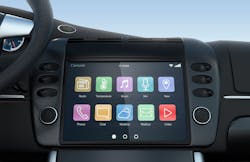How Apps Will Improve Auto Care Shops’ Access to Vehicle Data
You’ve likely heard of telematics technology at this point: After gaining access to a vehicle’s OBD-II port with a dongle hookup, your shop can directly connect with drivers and detect trouble codes to determine if service is needed. Real-time communication; instant access to OEM repair information; on-the-spot appointment booking—this is all available to you right now.
But even this technology, which has barely caught on, is already taking on new forms, says Jürgen Mayntz. And until independent repair shops prepare for those changes, dealerships and MSOs will continue to take advantage.
Mayntz is the founder of the German company High Mobility, a significant driver of connected car technology. The company won Frost & Sullivan’s 2017 award for “Enabling Technology Leadership” with its software that allows third-party developers to more readily develop apps for OEMs. This is a huge advantage for OEMs, as it gives them complete control over their vehicle data when companies like Apple and Google are vying for it in the growing connected car industry. In turn, it gives allied automotive industries, such as auto care shops, easier access to that vehicle data.
Mayntz spoke with Ratchet+Wrench to explain how app developers’ relationship with OEMs will change auto repair shops’ ability to digitally connect with vehicles and access repair data.
How important is app development to automakers?
Within just five years, estimates say the connected car market will be worth 50 billion euros—bigger than the core car sales. It’ll change how we buy cars. When a customer buys a car, he will ask, “How compatible is this car to all kinds of services offered now over the Internet?” This is how the future will look. The car will just be a platform for digital service.
When you buy a smartphone today, you’re not really looking at how it looks, the main factor for the purchase is, “What kinds of apps can you run on this?” This is what Microsoft fears. They don’t make big enough ecosystem to interest people to their smartphones. And the OEMs are scared of exactly the same thing right now. Because if a company like VW, which sells millions of these cars, says “No, I’m sorry, we don’t offer the apps you want for this vehicle,” then this becomes a deciding factor for the customer. All the OEMs understand this. The need is there, so these apps are made by third parties.
Why haven’t app developers been able to easily access OEMs’ vehicle data?
Each car has two IT systems. One is the infotainment system, which is accessible by Apple and Google. And the other one is the car’s API (application programming interface).
This is a problem for the OEMs and app developers, because each car has its own unique API. For example, if a company like Amazon wanted to create an app that opened the trunk on a car, they would have to make an app for each individual car.
So, what we have is a generic API that works with all cars, housed on our SDK (software developer kit). We do the mapping and provide a generic interface to the developers on the left side. Then, on the right side, we connect our API. This enables the OEMs to work with all the developers in the world and to develop those kinds of apps that work in all cars.
So, because apps have improved access to OEM data, how does that affect maintenance?
Let’s look at Apple and Google, who really want to get into the cars. If Apple and Google get access to the data as cars get on the Internet, then they own the data, and then the OEMs just produce these metallic things—they want to prevent this.
So, if they own the data, and all the data that comes from the car’s API, that includes all the data for maintenance. If something is broken down, if the sensor doesn’t work properly anymore, that data will become more readily available more quickly.
If someone wants to make a predictive maintenance app, then they can access to all the car data, and which is much more than what they could get through OBD-II port. And if they get the data, and something is broken down or about the break down, then they can send the message either to a smartphone or Google infotainment screen, and say, “Hey, here is something happening with your car, should we fix this for you? If you click this button, you can book an appointment for you.”
Does this improved access to OEM data translate to independent auto care shops?
Yes. Of course, the OEMs want to keep as much data as possible because they want to make as much money as possible. But that’s not really the case for older cars right now. For example, a company like BMW, they’re not really interested in repairing the old BMWs. They want to offer the service packages to new cars with these advanced systems because they want to sell those news cars.
So, this is where the independent repair shops come in, because BMW can offer their data to those shops, too. Of course, independent shops have to pay for this, but in this case, they could even get the data for newer cars, because the customer wants the apps, and the apps will develop preventative maintenance systems that independent shops can access.
Can’t OEMs create their own preventative maintenance apps?
OEMs will offer applications like that as well. Then they can send their customers directly to their own dealerships for service. This is where the OEMs can get more customers back to their own service shops.
The key here is developers and external companies are getting access to car data from the OEMs. OEMs want to participate in this game, because it’s just what the customer wants.
MSOs would create their own apps, too, right?
Multi-shop operations can also make apps and approach the OEMs and say, “Hey work with us.” And then they pay a certain amount of money to access the data, and then they can also offer this service with their own app.
What kind of companies is High Mobility working with?
We work with a japanese company, AGC, one of the biggest glass manufacturers for cars. We developed something called Smartglass. That windscreen has an intelligent matrix that can detect if something is broken. Something like a little chip can trigger an alarm and alert the customer, “If you don’t repair this, this will get much bigger.” And the customer can say, “OK, please repair this,” and AGC gets the location of the vehicle, and the service truck comes overnight and fixes the glass where it’s parked.

